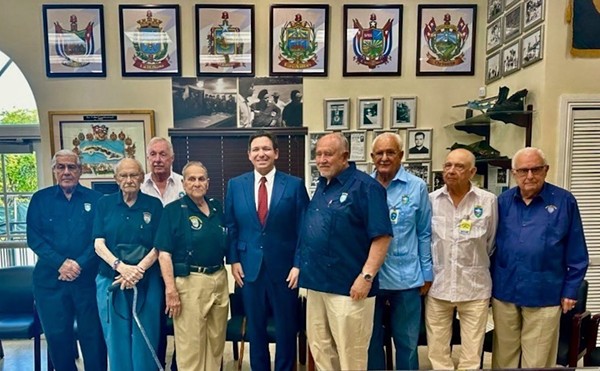The night he was thrown into the camp, Kerim Mesanovich thought he was a dead man. Already bloodied from a police attack, he found the walls of his prison spattered more than three feet up with blood from a mass beating that guards had given prisoners the day before. "I was 100 percent sure I would not see daylight," he says.
Mesanovich saw daylight, and the next night, and every day and night afterward for the next two months. Every moment was filled with the same fear — that he might not live to see the next. He witnessed, and was subjected to, brutality that compares in its own way to the Holocaust of World War II. Still, he lived. Others imprisoned with him did not.
Mesanovich, 49, is a survivor of the war in the Balkans, the conflict that in 1992 and 1993 hurled friend against friend, neighbor against neighbor, relative against relative and that ultimately drew the intervention of NATO troops. Mesanovich was among several thousand Bosnian Muslims who were imprisoned, beaten and otherwise abused by Serbian troops at a concentration camp in the northern Bosnian town of Omarska. Many of the prisoners did not survive the experience.
Now, 12 years later, Mesanovich lives a comfortable and quiet life in the blue-collar community of Pinellas Park in central Pinellas County. Yet he isn't being quiet about what happened during his days in hell. He is telling what he knows about those terror-filled times before the International Criminal Tribunal for the former Yugoslavia, in The Hague. In January, in his third appearance, Mesanovich testified against the man who fomented the conflict, Slobodan Milosevic, the former president of Serbia. In the Tampa Bay area, which is home to more than 4,000 Bosnian refugees, Mesanovich is one of the few Omarska survivors willing to tell what happened.
From Tampa, drive northeast on I-4 through Orlando to I-95, then north to Jacksonville, west on I-10 to Tallahassee, and back down to St. Petersburg on U.S. 19. You've driven the boundaries of a triangle roughly the size of Bosnia-Herzegovina. The region seems too quaint a place in which to shed blood. It's a succession of mountain ranges, with hundreds of villages nestled into the passes and along icy streams that flow down the country's crumpled topography. Where the streams reach the valleys and run together, centers of commerce sprout: Banja Luka, Sarajevo, Prijedor.Mesanovich was raised in Prijedor (pronounced pree-ah-door) from early childhood. His father was an elementary school teacher who, while raising Kerim and his brother, managed to put enough aside to buy a summer home in the countryside. After taking some college classes, the young Mesanovich got a job as a computer programmer for the Secretariat for National Defense where he handled top-secret documents of the Yugoslavian government every day. While attending the Center for Education for Young Communists, he was attracted to and later married one of his instructors, Nada Drakulic. Their daughter, Merima, was born in 1979.
He mentions Communism with no hint of political ideology. Membership in the party, he explains, was necessary to hold a meaningful job and receive a nice place to live. He and Nada had a "nice small apartment" with electricity and telephone. His salary was low — about $700 a month — but rent amounted to what an American might pay for a carton of cigarettes. Their standard of living "was better than East, but much worse than West." Still, "we didn't know for better."
Under President Josip Tito, any discussion of ethnic identity or religion was forbidden: "Everybody Yugoslav." Not that those things mattered much. "Nobody care about, especially in Bosnia," he says in heavily accented English.
Mesanovich is Muslim, his wife is Serb. Such "dirty marriages," as they were known, were commonplace. He estimates that in Croatia, about 80 percent of the families were of mixed ethnic heritage; in Bosnia, about one-third. Muslims there had nothing in common with those of the Middle East. Bosnian Muslim women "never took scarf," Mesanovich says. The Muslim population drank liquor, smoked and gambled, all practices forbidden by Koranic law. "I wasn't really that Muslim," he says, noting that he was never given any religion classes as a child and didn't attend a mosque. "We had only names" as markers of a person's ancestry, and his first name identified him as Muslim.
Mesanovich remembers the day when it all changed: April 30, 1992. Everything that was familiar became unpredictable; everything that hadn't mattered attained great gravity. That day, the Serbian army rammed its way into Prijedor. The month before, Bosnia-Herzegovina had declared its independence after a republic-wide referendum that had been opposed by Serb political and military forces.Prijedor, a city of about 112,000, was balanced in its population of Serb and Muslim residents, with about 39 percent Muslim and 40 percent Serb. But now it was the Serbian flag that flew everywhere in town. Serbs took control of the police stations, banks and post offices. "Over one night, you change your mind," recalls Mesanovich. "We working together, we live together, we laughing together. And only one night, you change your mind. I'm not your friend. I'm not your relative, I'm not your neighbor."
Everything changed, including Mesanovich's workplace. Over the next several weeks, half a dozen Muslim workers were fired. He was kept on and given the job of arranging Serbian troop mobilizations. But on June 24 he was taken to the police station, for no apparent reason other than being Muslim. That night he was beaten. A police officer, wearing heavy boots, kicked in Mesanovich's lower teeth. Mesanovich fell to his knees, his jaw broken, and was then hit in the back.
By 10 p.m. that evening, when Mesanovich was taken to Omarska, his shirt was stained red from his own blood. His eyes were swollen shut. He remembers nothing of the assault. Only years later did a friend who was present at the police station describe to him what happened.
Omarska sits at a junction of road and stream at the eastern end of a valley in the southern foothills of the Kozara Mountains. Whatever charms the hamlet of 4,400 possessed before the conflict are now stigmatized by events that occurred at a place probably not on any sightseeing brochures of the time.A defunct iron ore mine and processing plant on the outskirts of town were converted, virtually overnight, to a place where people languished and died, sometimes in horrible ways. Of the 28 concentration camps the Serbs established throughout Bosnia, the one at Omarska is considered the place where the most horrific atrocities were committed.
Omarska was a place where cruelty and mass murder had become a form of recreation. The guards were often drunk and singing while they tortured. A prisoner called Fikret Harambasic was castrated by one of his fellow inmates before being beaten to death. One inmate was made to bark like a dog and lap at a puddle of motor oil while a guard and his mates from the village jumped up and down on his back until he was dead. The guards would make videos of this butchery for their home entertainment. But the most extraordinary hallmark of the carnage was its grotesque intimacy. People knew their torturers, and had often grown up alongside them.
—Ed Vulliamy, a British journalist who discovered the Omarska camp, writing in The Nation, June 10, 1996.
Mesanovich was placed in a former administration building dubbed the "White House" where he was confined with about 45 other men. Three days later he was transferred to the "Glass House," which Mesanovich described as a "big bedroom."
Yet there were no beds, not even a roof. Prisoners slept on blankets on the tile and concrete floor. An overhang on one end provided only the slightest protection from the elements. Even so, the men there were lucky. Another 250 people slept totally unprotected on the "pista," a wide concrete walkway between two buildings. In all, perhaps 3,000 prisoners, mostly men and mostly Muslim, were held at the camp.
Fleas infested the camp. The pests must have gotten to the guards as well because after two weeks a powder was spread around and the problem disappeared. Prisoners, in groups of 30, were fed a small piece of bread and thin soup and given only three minutes to consume the whole meal.
None of the prisoners at Omarska were allowed showers or changes of clothes. Prisoners stumbled around on their knees or scooted on their rumps. Anyone who stood risked being shot by the guards.
Interrogations went on 8 to 5 six days a week. Abuse by the guards was not uncommon. Once, during lunch, a guard hit Mesanovich with a helmet, causing him to fall and hit his head on the concrete floor. Another time, Mesanovich was attacked while walking on the pista.
Guards prevented the prisoners from relieving themselves for 12 hours at a time. This Mesanovich remembers most vividly. "Go home and sit 12 hours," he instructs. "Don't go to the bathroom. No, no you can't. Because, you know, you can't go, yet [your body] says you must."
The concentration camp premises were sometimes so packed with people that no more inmates could be crammed in. On at least one occasion, this allegedly resulted in an entire bus-load of newly captured people being arbitrarily executed en masse.
—from a report by the United Nations Commission of Experts to the Security Council, December 1994
Death was a constant presence. Many mornings around dawn a small yellow truck left the camp, headed up into the Kozara. It was filled with the dead. The guards extorted money from prisoners with the promise that they would be spared. The prisoners died anyway.
A colleague, Muhamed Burazorovic, a "very good, very close friend, very good man," died from a beating three days after Mesanovich arrived at the camp. His aunt's son-in-law, who had been a police inspector, died July 25. "It was a Saturday afternoon when they killed him," Mesanovich says. He seems intent on remembering these small details. Slowly, letter by letter, he spells out the names of those he knew who died there, as if to honor their memory, to never forget them.
He estimates that Serbs killed about 80 percent of the "educated people" interned at Omarska: the Muslim doctors, attorneys, engineers, and business people. At the end, only one doctor was left, Mesanovich recalls, and only then, he thinks, because the doctor had worked in the ambulance service in Omarska. Although relationships had been torn apart by the war, they still mattered. Mesanovich was spared because the camp commander, Zeljko Mejakic, was a relative. (Mesanovich's brother was married to Mejakic's sister.) It was Mejakic who transferred him to the "Glass House" to ensure his safety. Nada remembers that when Mejakic had meetings in Prijedor, he would stop by her apartment to reassure her that Kerim was still alive. Little Merima, unaware of the commander's link to her missing father, would greet him with a hug.
Mesanovich doesn't know the total number who died. About 150 were shot to death in one night, he believes. Some days, no one died. In two months, maybe 1,000 were killed, about a third of those held. "We never count," he says, "because we never know. Maybe more, maybe less."
In late July that year, Western television crews entered Omarska to report on conditions. Camp officials dressed about 150 prisoners in pajamas, gave them beds and good meals and televisions, according to Mesanovich, to show that conditions weren't bad at all. Mesanovich wasn't among those gussied-up prisoners, but a camera crew got footage of him and others lying on blankets in the White House, looking more like clothes hangers than humans. A cut over his eye was still visible from the beating he had received from police in June. (That picture was used years later at the International Court of Justice to prove his presence at Omarska.)Press revelations of such grim scenes so inflamed the West that the Serbs were forced to close the camps. Mesanovich was released Aug. 7. He had never weighed more than 180 pounds; he left the camp at about 110. "I was really lucky, because I alive after two months."
To commemorate his survival, Mesanovich marks Aug. 7 as his "second birthday."
Within a few days of his release, Mesanovich returned to Prijedor, bought a fake ID, and he, Nada and Merima fled Bosnia. They stopped running when they reached Germany, where they stayed for five years.
A German friend suggested that Mesanovich write down what had happened to him while the memories were fresh.
He was interviewed on the radio. Perhaps as a result, a Bosnian attorney attached to the tribunal at The Hague contacted him. After Mesanovich and his family moved to Pinellas Park in 1997, drawn by the presence of friends from Prijedor, he was interviewed again.
Mesanovich was first called to testify in the spring of 2000, against the camp guards. He was there 10 days, a time that was "really bad" for him. The stress of testifying so long, remembering all those things he wanted to forget, gave him a bleeding ulcer. Afterwards, however, "I felt so good."
"Finally, somebody listen to me. After so many years, I saw again guards and shift commanders but from a different position. Now I see them like a free man." And the guards were not free.
In April 2001, he testified against the so-called "crisis staff," Bosnian Serb former deputy prime minister, Radislav Brdjanin, and Serbian Army chief of staff, General Momir Talic. Talic died in 2003 before the conclusion of his trial.
Between Jan. 20 and 23 of this year, Mesanovich testified against Milosevic for a total of two-and-a-half hours. Much of the questioning dealt with his office work helping to arrange troop movements and his knowledge of the organization of the concentration camp. That trial is ongoing. The case against Mejakic, the Omarska commander charged with genocide, crimes against humanity and war crimes, is in the pre-trial stage. Many of the mass graves have not yet been found. Mesanovich hopes that Mejakic will reveal where they are.
Despite all that he has endured, Mesanovich is surprisingly forgiving. He doesn't support either the death penalty or life sentences for any of those convicted. Give Milosevic 25 years in prison, he says. The former Serbian president, 63, will be an old man when he gets out. "Lifetime, that's bad. It's almost like execution. You're going to die probably after 30 years."
Mesanovich may be called to The Hague again in the fall. "I will not stop because I was lucky," he says. "So many people had bad luck and they died. That's my fight against crime."
It‘s been a struggle,but life is normal again. Mesanovich looks fit, without a hint of any weakness from his time in Omarska. He works as the lead electrician for house manufacturer Jacobsen Homes. He, Nada, and two dogs — a German shepherd and a poodle — live in a tidy, single-family neighborhood across the street from a church. Merima lives in St. Petersburg and has two children. "Third time with my short life that I start with a spoon and fork," Mesanovich declares. "First time, my country; second time Germany and third time, and I hope should be last time, U.S.A."He has adapted well to the ways of capitalism. A big-screen television takes up one corner of his living room, near the fireplace. Relatives visiting from Serbia splash in the pool out back. "It's a little bit different," living in America, he says. "Maybe different food. Music is same. Clothes same. All time we watch same movies, all time we read same books."
His home and possessions in Prijedor are lost to him. However, Mesanovich says, "I think I am happier than them" because he is working and experiencing a normal life in a country that "doesn't care who are you." Prijedor, he says, "is not my city anymore. Too many bad people inside and too many people died for nothing." Serbians continue to support Milosevic, even though their economy is in shambles. They have "no water, no music, no car, no nothing." Nada's niece is a physics professor in Novi Sad, where her family lives on $150 a month.
For the next 20 or 30 years, Mesanovich says, "you can't see anything better" for Bosnia.
As to lessons learned from the war? "I don't know really what, because I still don't have any answers what happened over there." Some 12 years after the end of the war, "I still can't understand it," he says.
He has learned that "what's important is your life, your friends and your kids."
And remembering. While in Germany, he met Simon Weisenthal, a survivor of the Holocaust who has dedicated his life to capturing and bringing to justice former members of the Nazi regime. Weisenthal told him that despite the passage of years, "I'm still in Auschwitz."
"Probably I will never forget what happened," Mesanovich reflects.
Mesanovich knows 15 to 20 survivors of Omarska who live in the Tampa Bay area.At the request of a reporter, he has called a few of them to come to his home, to share their experiences. Forty-five minutes after the scheduled arrival time, no one has appeared.
"Those idiots," Mesanovich fumes. But he is quickly forgiving. Many of those who lived to tell what happened just want to forget, he says. Others, perhaps still attuned to the old ways of Tito, are afraid to speak out publicly for fear of repercussion. What can happen to them, asks Mesanovich out loud. This is America.
Yet they will talk in their private circles, gathering as fraternity brothers to reference emotions and moments only those who lived through Omarska can fathom. They speak of things that happened to them in that small town, where between the lush mountains and the sparkling rivers a black hole of perversity gobbled up humanity. "Always, always, same story, same words," Mesanovich says.
And, he continues, there's always the same question: "Why? Why?"
Melvin Baker is an independent journalist. He can be reached at [email protected].
















